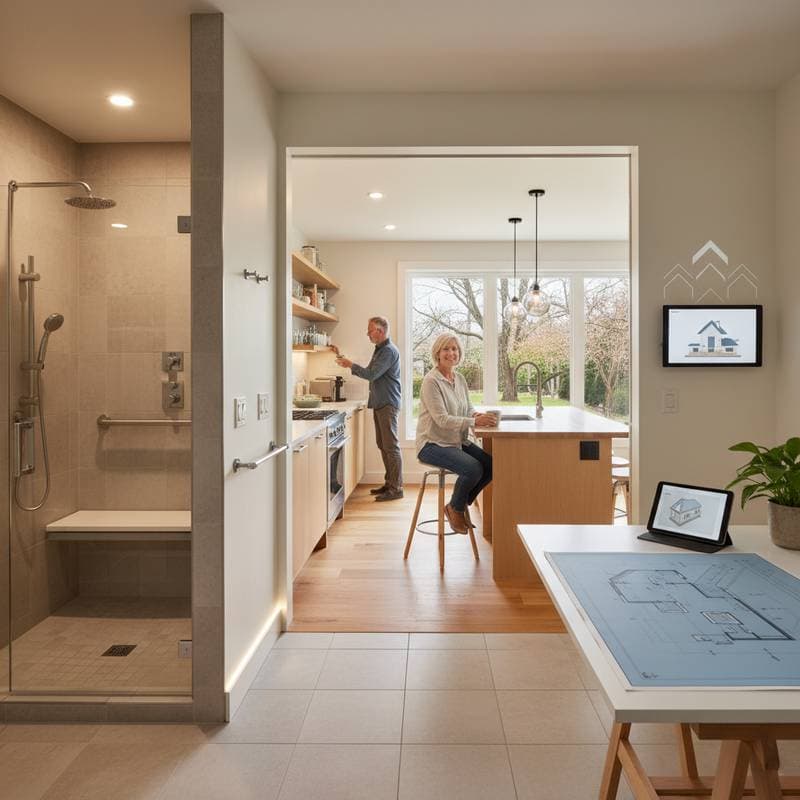Understanding Universal Design in Home Remodeling
Universal design focuses on creating spaces that accommodate people of all ages, abilities, and sizes. This approach integrates accessibility features seamlessly into the home's aesthetics, ensuring functionality without compromising style. Homeowners often pursue these remodels to prepare for long-term living, particularly as they age.
The principles of universal design include equitable use, flexibility, and simplicity. For instance, features like zero-step entries and adjustable counter heights allow easy adaptation over time. Such modifications promote independence and reduce future renovation needs.
In 2025, demand for these remodels grows with an aging population. Builders emphasize durable, low-maintenance materials to align with sustainable practices. This shift makes universal design a practical choice for modern households.
Benefits of Universal Design for Aging in Place
Aging in place enables individuals to remain in their homes comfortably as mobility changes occur. Universal design remodels address common challenges, such as navigating stairs or reaching cabinets. These enhancements prevent accidents and support daily routines.
Safety improvements, like better lighting and handrails, lower the risk of falls. Comfort features, including wider pathways, ease movement for everyone in the household. Beyond immediate use, these upgrades appeal to a broader market if resale becomes necessary.
Property values often increase with thoughtful accessibility additions. Studies show that homes with universal features sell faster and at higher prices. Owners gain peace of mind knowing their space evolves with their needs.
Breaking Down the Costs: $18,000 to $75,000 Range
Basic universal design projects start around $18,000. These typically involve targeted updates, such as installing grab bars in bathrooms and replacing doorknobs with levers. Such entry-level remodels focus on high-impact areas without extensive structural changes.
Mid-range renovations, costing $30,000 to $50,000, expand to kitchen and hallway modifications. Examples include lowering sinks for wheelchair access and adding non-slip flooring throughout main living spaces. Labor and materials dominate these budgets, varying by region.
Comprehensive overhauls reach $75,000 or more. Full-home adaptations might incorporate ramps, elevator installations, and smart home technology for voice-activated controls. Custom elements, like reinforced walls for future lifts, push costs higher but ensure longevity.
Factors That Influence Universal Design Remodeling Expenses
Project scope determines the baseline cost. A single-room update remains affordable, while whole-home transformations demand larger investments. Homeowners must assess their priorities to allocate funds effectively.
Material choices significantly affect pricing. Opt for durable options like vinyl composite flooring over luxury tiles to balance quality and budget. High-end fixtures, such as touchless faucets, add convenience but increase expenses.
Location plays a key role in labor rates. Urban areas charge more due to higher demand and permitting fees. Rural settings may offer savings, though material shipping could offset those benefits.
Contractor expertise also impacts totals. Experienced professionals in accessibility design prevent costly errors. Obtain multiple quotes to compare value, ensuring the team understands universal principles.
Essential Upgrades and Their Associated Costs
Wider doorways facilitate movement for mobility aids. Resizing standard 32-inch openings to 36 inches costs $1,500 to $3,000 per door, including framing adjustments. This change benefits wheelchairs and walkers immediately.
Grab bars provide stability in wet areas. Installing reinforced models in showers and along hallways runs $200 to $500 each, with professional fitting recommended for safety. Select ADA-compliant versions for maximum support.
Lever-style handles replace traditional knobs for easier operation. Updating throughout the home totals $500 to $1,500, depending on finish choices. These simple swaps enhance usability for arthritic hands.
Non-slip flooring reduces fall risks. Replacing carpet or tile in key zones costs $3,000 to $8,000 for 500 square feet. Choose textured surfaces that maintain visual appeal.
Adjustable-height counters in kitchens allow versatile use. Retrofitting existing cabinets averages $2,000 to $5,000. This feature supports both standing and seated cooking.
Smart lighting and controls automate routines. Installing motion-sensor lights and programmable thermostats adds $1,000 to $4,000. These systems integrate with voice assistants for hands-free operation.
Strategies to Control and Offset Remodeling Costs
Phased planning spreads expenses over time. Start with bathroom safety features, then address the kitchen later. This method maintains cash flow while building toward full accessibility.
Seek grants and tax credits for eligible projects. Programs like those from the U.S. Department of Housing and Urban Development support aging-in-place initiatives. Local nonprofits may offer additional assistance for low-income households.
Incorporate DIY elements where skills permit. Painting walls or assembling simple shelving saves on labor. Always consult professionals for structural or electrical work to avoid hazards.
Compare financing options, such as home equity loans with favorable rates. Energy-efficient upgrades, like LED lighting, qualify for rebates that lower net costs. Track all expenses for potential deductions.
Boosting Home Value with Universal Design Features
Accessibility modifications attract diverse buyers. Homes with these elements command 10 to 20 percent higher sale prices in competitive markets. The investment yields returns through quicker sales and reduced upkeep.
Universal design enhances curb appeal subtly. Smooth ramps blend with landscaping, while interior updates modernize spaces. Potential buyers appreciate the forward-thinking approach.
Long-term savings emerge from preventive measures. Fewer injuries mean lower medical bills, and durable features resist wear. Owners enjoy a higher quality of life alongside financial gains.
Planning Your Universal Design Remodel
Assess your home's current layout with a professional walkthrough. Identify priority areas based on daily habits and future needs. Create a detailed wishlist to guide discussions with contractors.
Set a realistic budget with a 10 to 15 percent contingency for surprises. Research local regulations to ensure compliance with building codes. Timeline expectations help coordinate disruptions minimally.
Select a contractor specializing in universal design. Review portfolios for similar projects and verify certifications. Clear communication establishes trust and aligns visions.
Monitor progress with regular updates. Test features upon completion to confirm functionality. This thorough process secures a remodel that serves for decades.
Achieving Lasting Independence Through Smart Renovations
Universal design transforms homes into supportive environments. These remodels foster safety, comfort, and equity for all residents. By investing thoughtfully, homeowners secure independence and value for years ahead.










